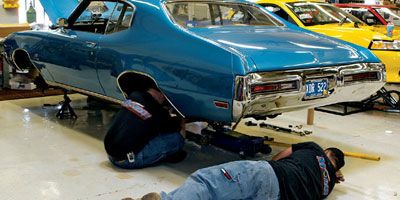
Before this tune-up, when the green light lit this '71 Buick Skylark would smoke the Mickey Thompson stickies down the first 100 feet or so of the track before hooking up and running. The starting-line tirespin was maddening. Part of the solution we'll show here applies to production cars with coil-sprung, nonparallel four-link rear suspensions such as '64-'72 GM A-bodies (Chevelles, Skylarks, Cutlasses, and Tempests) and Fox-and-newer Mustangs. Next month, we'll dial it in.
We sought guidance from world-reknowned street-racer-turned-Pro-Street-guru Mike Moran, who has raced every kind of vehicle you can imagine and coaches a lot of Fastest Street Car racers through his business, Moran Motorsports. Surprisingly, he started his quarter-mile passion behind the wheel of an A-body Buick, so he knows these vehicles. Moran's initial suggestion was simply to change the shock absorbers to help speed up and control the transfer of weight from the front end for added bite, but after discovering the car's poor 60 percent front-end weight bias, Moran and his business partner Bart Lemeux decided that some more serious suspension parts might be needed.
The plan involved installing a Dick Miller Racing (DMR) rear-suspension kit to improve the launch grip of the vehicle. The kit repositions the upper-link mounting points on the rearend housing to alter the four-link geometry, moving the theoretical intersection point of the upper and lower control arms lower and rearward. This changes the leverage point of the suspension, leading to more body rise during launch, and therefore more pressure on the tires for improved traction. The DMR kit is also adjustable to preload the suspension for drag tuning, and it stiffens the factory mounting points. Similar kits are available for coil-spring Mustangs.
The suspension overhaul also included a DMR adjustable, preloadble rear sway bar and Strange adjustable shocks. We had to modify some of the DMR components to fit, because a Moser 9-inch rearend was installed a few years ago in place of the stock GM 10- bolt , and this kit is built for a factory rearend.
Consulting For Speed
In the process of doing the upgrade in this story, we reached out to the owner of one of the quickest streetable Buick Skylarks in the country. Steve Cagle has gone 9.49 seconds at 146 mph with a 1.36 60-foot time in a 3,500-pound '71 Buick.
When asked about getting the car to launch, Cagle said, "We spent a lot of time with the stock rear suspension and eventually installed a fully fabricated racing suspension. The Dick Miller pieces and Strange shocks are great with the stock suspension and can be installed by someone in his driveway. We ran the rebound in the rears set at seven clicks toward stiff and the fronts at halfway to stiff. I'd set the pinion angle at 3 degrees down with the Dick Miller suspension. We put a lot of pressure in the slicks compared to a lighter car, like 1111/42 to 13 psi, and with the vehicle weight, I think that would help you-we also ran tubes in our slicks. My car worked well with Moroso big-block drag springs up front, but with the front-end weight of your vehicle, I don't think they'll work."
We did try the Moroso front drag springs, which were very difficult to install as they're very long. Unfortunately, the nose weight was too much-the springs were in full coil-bind with the car at rest, so the stock front springs were reinstalled for all the runs.
Cagle went on to add, "Any weight you can get out of the front of the vehicle will help a bunch at the launch." We looked at removing weight, but decided to just focus on the suspension for this story.
Cagle's advice helped a lot. One example was his recommended optimal front-suspension alignment-which saved time for us. We suggest finding someone who has gone fast with the same type or a similar-type vehicle to give you speed tips. Don't be a pest: You'll need to make it a win-win somehow-and we're sure they are as busy as everyone else. Basic recommendations for alignment are to set the alignment with the car raised 1 inch from ride hieght. Shoot for 3-4 degrees of positive caster and 0 camber, and a total of 11/416-inch toe-in. The positive caster helps with high-speed stability.
One important caution: You will need to make sure the vehicle is similar enough to yours to translate. If the package is dramatically different from what you have, there is little to learn-but what do you have to lose in asking?
Scaling The Car
To start the improvement process, Moran asked the vehicle's owner, Mike Kunkle, to have the car weighed. Kunkle took his Buick to Wheel to Wheel Powertrain to have it put up on the electronic scales. Here are the results: As Moran suspected, the front-end percentage was brutal. This makes hooking up the rear tires at launch a real challenge. In a perfect world, he says, you'd want almost a 50/50 percent split front/rear with a suspension designed to take advantage of it.
Some of the additions to the vehicle after this weighing included the DMR suspension (10 pounds), seatbelts (10 pounds), and rollcage (80 pounds). While the car wasn't reweighed after these parts were added, we're confident the total weight was more than 3,700 pounds.
STARTING WEIGHT